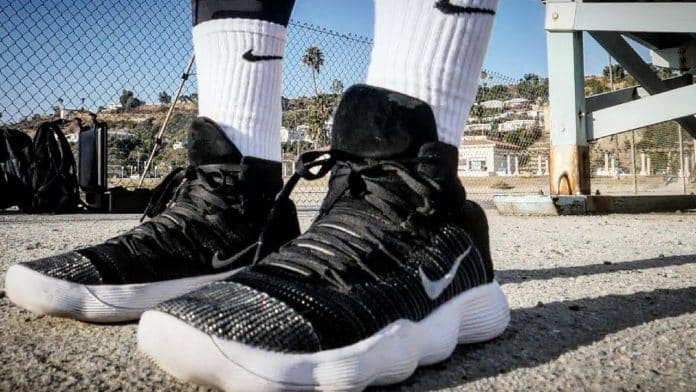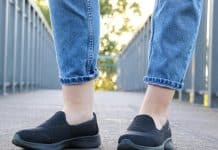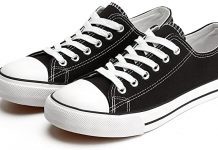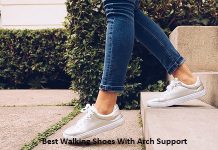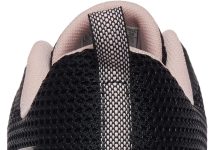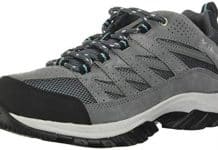We’ve all faced the dilemma of choosing the perfect pair of shoes for every occasion. With an overwhelming array of options, finding the right fit can be a challenge.
That’s where we step in! In this article, we’ll guide you through the world of footwear, helping you avoid those shoes that are better left untouched.
From uncomfortable heels to worn-out sneakers, we’ll share our insights so you can skip past the wrong shoes and stride confidently toward the right ones.
Let’s get started on this exciting journey of finding the perfect shoes!
Shoes with Poor Arch Support
Flat Soled Shoes
Flat-soled shoes may be famous for their minimalist design and sleek appearance, but they often lack arch support. The absence of any arch support can lead to discomfort and pain, particularly for individuals with flat feet or fallen arches. Wearing flat-soled shoes for an extended period can cause strain on the feet, resulting in conditions such as plantar fasciitis or Achilles tendonitis. To ensure proper foot alignment and reduce the risk of foot-related issues, opting for shoes with adequate arch support is advisable.
High Heels
While high heels may be a staple in many wardrobes, they are notorious for their poor arch support. The exaggerated heel height causes an unnatural weight distribution on the feet, leading to an increased risk of foot pain and discomfort. Prolonged wear of high heels can also contribute to the development of conditions like bunions and hammertoes. If high heels are a must, it is recommended to choose styles with built-in arch support or consider using orthotic inserts to provide additional comfort and support.
Flip Flops
Flip-flops are famous for warm weather and casual outings but lack proper arch support. Most flip flops have completely flat soles, which can lead to strain on the arches, as the feet have to work harder to stabilize with each step. Additionally, flip-flops offer minimal protection and shock absorption, leaving the feet vulnerable to injuries and discomfort. It is best to reserve flip-flops for short periods and opt for sandals with more supportive features for all-day wear.
Shoes with Thin Soles
Ballet Flats
Ballet flats are often favored for their versatility and classic design, but their thin soles provide little cushioning or shock absorption. The lack of adequate support can result in increased pressure on the feet, leading to conditions like metatarsalgia or stress fractures. If ballet flats are a preferred choice, consider investing in brands that offer cushioned insoles or adding inserts for extra support.
Canvas Shoes
Canvas shoes, although lightweight and breathable, may not be the best option for individuals seeking arch support. The thin and flexible soles of canvas shoes offer minimal protection, and the lack of proper arch support can result in foot fatigue and discomfort. It is advisable to choose canvas shoes with supportive features, such as cushioned insoles or molded footbeds, to enhance comfort and overall foot health.
Ill-Fitting Shoes
Pointy-Toed Shoes
Pointy-toed shoes may be stylish, but they often contribute to ill-fitting footwear. The narrow and tapered design can compress the toes, leading to various foot conditions such as corns, bunions, and ingrown toenails. These shoes can also cause discomfort and pain in the ball of the foot due to the increased pressure on a smaller surface area. It is recommended to choose shoes that provide adequate toe room and opt for a wider toe box to allow for natural toe splay.
Narrow Shoes
Wearing narrow shoes can be detrimental to foot health and overall comfort. Too narrow shoes can compress the toes and lead to discomfort, blisters, and even nerve issues such as Morton’s neuroma. It is crucial to select shoes that accommodate the natural width of the feet, allowing toes to move freely and reducing the risk of foot-related problems. Opting for comprehensive or extra-wide shoe options can provide the necessary comfort and prevent the potential adverse effects of narrow shoes.
Too Tight Shoes
Wearing shoes that are too tight can cause a myriad of foot problems. Tight shoes can lead to blisters and calluses and even restrict blood circulation. Continuous pressure on the foot can result in discomfort and pain, making it essential to choose shoes that provide sufficient room for proper foot movement. The right shoe size should allow enough space for toes to wiggle freely, preventing the development of foot ailments associated with tight shoes.
Poorly Constructed Shoes
Cheap Knock-offs
Cheap knock-off shoes may be tempting due to their affordability, but they often lack the quality and construction necessary for optimal foot support. These shoes are often made with subpar materials and may not provide adequate cushioning or flexibility. Poorly constructed shoes can lead to discomfort and blisters and even exacerbate existing foot conditions. Investing in higher-quality footwear may be a wiser choice in the long run, as it promotes proper foot health and provides better overall support.
Glued Soles
Shoes with glued soles may offer limited durability and stability. Over time, the adhesive to attach the sole to the shoe can weaken, leading to separation and potential instability. This can affect the overall comfort and longevity of the shoes, as well as the support provided to the feet. Opting for shoes with sewn or securely attached soles can ensure better durability and minimize the risk of sole detachment.
Shoes with Insufficient Cushioning
Old or Worn-Out Athletic Shoes
Athletic shoes that are old or worn-out may lack the necessary cushioning and shock absorption to protect the feet during physical activities. Over time, the midsole of athletic shoes can become compressed and lose its ability to absorb impact, putting additional stress on the feet, joints, and muscles. It is important to regularly replace athletic shoes to maintain optimal cushioning and protect against potential injuries.
Slippers
Often used for indoor comfort, slippers may not offer sufficient cushioning for prolonged wear. Slippers’ soft and plush materials do not always provide the support or shock absorption required for proper foot health. Additionally, slippers can contribute to poor posture and foot alignment due to their lack of structure. For individuals who frequently wear slippers, it is advisable to choose options with built-in arch support or pair them with supportive insoles to enhance comfort and foot stability.
Hard-Soled Shoes
Shoes with stiff soles, such as specific dress shoes or formal footwear, can harm foot health. The lack of cushioning and shock absorption can lead to discomfort and contribute to conditions like plantar fasciitis or heel spurs. Hard-soled shoes also do not conform to the foot’s natural shape, potentially causing foot fatigue and reducing overall comfort. Opting for shoes with softer and more flexible soles can help alleviate these issues and provide better support.
Shoes with Restrictive Toe Boxes
Western Boots
While Western boots are beloved for their rugged style, the narrow and pointed toe boxes can lead to discomfort and foot problems. The limited toe space can compress the toes and contribute to the development of conditions like bunions or corns. Choosing Western boots with broader toe boxes that allow for natural toe splay and minimize the risk of toe-related issues is advisable.
Stilettos
Stilettos, with their elongated and narrow toe boxes, can create a host of foot problems. The tight fit and high heel height can force the foot into an unnatural position, causing strain on the toes and ball of the foot. Wearing stilettos for extended periods can lead to conditions such as hammertoes, metatarsalgia, and even stress fractures. It is essential to prioritize foot health and consider alternatives that offer more comfort and support for daily wear.
Shoes That Promote Bad Posture
Platform Shoes
Platform shoes, known for their elevated soles, can negatively impact posture and foot alignment. The exaggerated height difference between the front and back of the foot can shift the body’s center of gravity, leading to an unnatural posture. This can place excessive strain on the ankles, potentially contributing to issues like lower back pain. While platform shoes may be fashionable, opting for shoes with more balanced heels is advisable to maintain good posture and minimize the risk of discomfort.
Backless Shoes
Backless shoes, such as mules or slip-ons, do not provide adequate foot stability or support. The lack of a secure back or heel strap can cause the foot to slide and strain the muscles, leading to discomfort and potential injuries like sprained ankles. Backless shoes also do not provide proper arch support and can contribute to poor foot alignment. To ensure better foot stability and support, it is recommended to choose shoes with secure back straps or opt for styles that offer more structure.
Unsupportive Sandals
Thin-Strapped Sandals
Sandals with thin straps may be fashionable, but they often lack the necessary support for all-day wear. The slim straps can dig into the skin and cause discomfort, leading to blisters or abrasions. Additionally, thin-strapped sandals usually do not offer sufficient arch support or cushioning, potentially contributing to foot fatigue and pain. It is advisable to choose sandals with thicker, adjustable straps that provide better support and allow for a custom fit.
Plastic Flip Flops
Plastic flip-flops may be inexpensive and easy to wear but typically offer minimal support and cushioning. The lack of arch support and proper shock absorption can result in foot strain and discomfort, mainly when worn for extended periods. Plastic flip flops can also lead to increased friction and blister formation due to the non-breathable material. It is best to choose flip-flops made of more supportive materials, such as cushioned EVA or rubber, which provide better foot comfort and stability.
Shoes That Cause Pain
High Heeled Sandals
High heeled sandals may be stylish, but they can cause significant pain and discomfort. The combination of elevated heels and minimal foot support can lead to many foot problems, including plantar fasciitis, Achilles tendonitis, and ankle instability.
The lack of arch support and the increased pressure on the balls of the feet can cause pain and fatigue, making it difficult to walk or stand for prolonged periods. Consider opting for lower-heeled sandals with built-in arch support to alleviate pain and provide better foot stability.
Tight Shoes
Wearing too-tight shoes can result in immediate pain and long-term foot problems. Tight shoes can compress the feet, leading to discomfort, blisters, or even nerve issues.
Choosing shoes that fit correctly and allow for natural foot movement is crucial. Ensuring ample room for toes to wiggle and avoiding constrictive footwear can prevent unnecessary pain and potential foot ailments.
Shoes That Lack Stability
Worn Out Sneakers
Sneakers that are worn out can significantly impact foot stability. As the cushioning and support within the shoe’s midsole degrade over time, the feet are left vulnerable to excessive impact and strain. The lack of stability can lead to foot fatigue and discomfort and even contribute to ankle or foot injuries. It is recommended to regularly replace sneakers to maintain optimal support and prevent potential instability.
Slip-On Shoes
Slip-on shoes, although convenient, can lack the stability and support needed for proper foot health. The absence of laces or straps can result in an inadequate fit, causing the foot to slide or move within the shoe. This can contribute to foot instability and discomfort, increasing the risk of falls or injuries. If slip-on shoes are desired, choosing styles with elastic or adjustable bands can provide a more secure fit and improved stability.
In conclusion, while specific shoes may be fashionable or convenient, it is essential to consider their potential adverse effects on foot health and overall well-being. Investing in shoes with proper arch support, sufficient cushioning, and appropriate fit can promote comfortable and pain-free walking.
Prioritizing footwear that prioritizes stability and promotes good posture can help prevent potential foot problems and support optimal foot health for the long term. Remember to listen to your feet and choose shoes that provide the necessary support and comfort they deserve.

